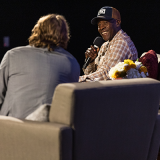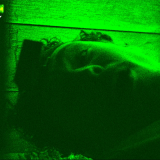Documentary Editing Workshop Gives Tips On How To Make The Story
November 3, 2016
Editing is a tough job, especially when it comes to documentaries. Not only do you have to go through hours of footage, but the editor is also the one who has to craft a story around it. They are literally in control of the emotional impact of the film, finding the heart and soul within the narrative, and making sure it all ties together in the end.
How does someone do this daunting job? That’s the question that editor Jacob Bricca shared a few weeks ago when he hosted a workshop here at Dodge College all about it. Bricca is an award-winning Tucson-based documentary editor, director, and teacher. He has edited over a dozen feature films, including the international theatrical hit Lost In La Mancha.
During the workshop, he talked about the processes he has developed over his career, such as how to find narrative threads, how to build effective scenes, and get the most out of the material at hand.
Bricca started off his class by explaining that Apple’s Steve Jobs made a statement once about how users wanted their products to be more direct. He explained that this can be applied to film as well.
“Say what you mean in the most direct way you can,” said Bricca. “Simple is better. Making some form of clarity is what you seek in documentary films.”
He went out to talk a bit about his editing principles, and gave some tips about what people can do when editing documentaries.
First, he said you have to trust in the process.
“Find the purpose of the scene,” he explained. “When you do a documentary, you try to create scenes out of footage that you don’t even know what they are yet. A scene in one part of film will have different meaning in another part.”
He suggested taking it one step at a time, and the next step will reveal itself.
“Despair is normal at this stage, because it happens on all films,” he joked.
Next, you need to contain the chaos.
“Make the problems cleaner and smaller,” Bricca said. “If you break them down into smaller tasks, you have a shot at it.”
He said that he likes to make categories, and subcategories, to help ingest and organize all the clips. He sometimes creates categories simply based on the ‘feel’ of a certain clip, to see if it will come in handy later.
He also said that he looks for repetition, and that sometimes that can build into natural montages that you wouldn’t even have guessed were hiding in all the footage.
Then, he said you need to anchor with the narrative.
Within the clips, you need to show the character’s conflict and their progression, and how it all ties together with the main story.
And finally, delay gratification.
Conceal the pay off, and then when you reveal it to viewers at the end, it will be much more satisfying.
Bricca will be expanding upon all these principles in a book he is currently working on titled Documentary Editing: Principles and Practices.
Overall, the workshop was a huge successful, and students walked away with a better idea of how to tackle documentary editing.
Speaking of documentaries, are you interested in our Documentary Program here at Dodge? Join us for Documentary Night, featuring a panel of documentary visionaries who will discuss the wide variety of careers available in the field. Come learn about the documentary programs at Chapman and how you can get involved in this rewarding career track. All programs are welcome to attend.
It will be held on Thursday, November 3 at 7:30 p.m. in the Cloobeck Screening Room, Digital Media Arts Center.


